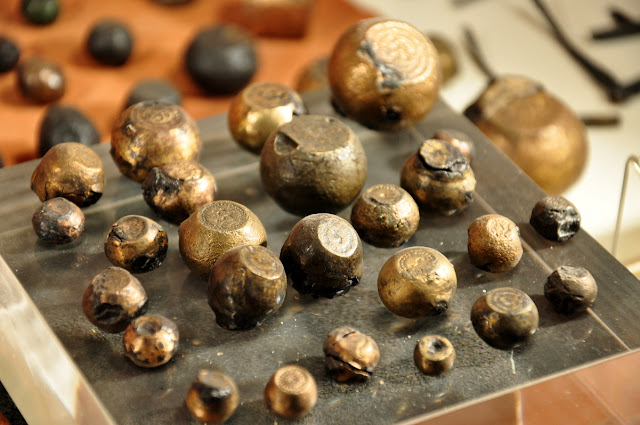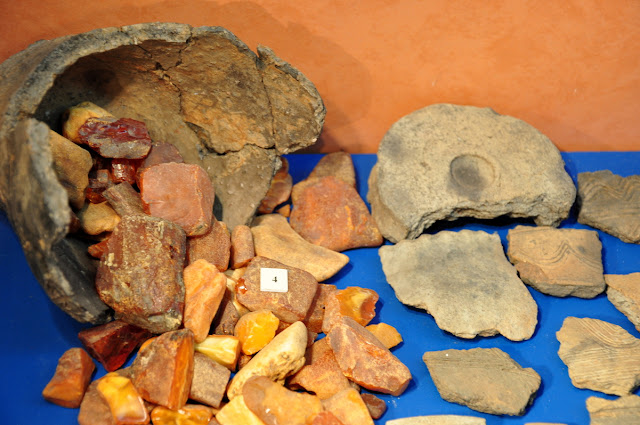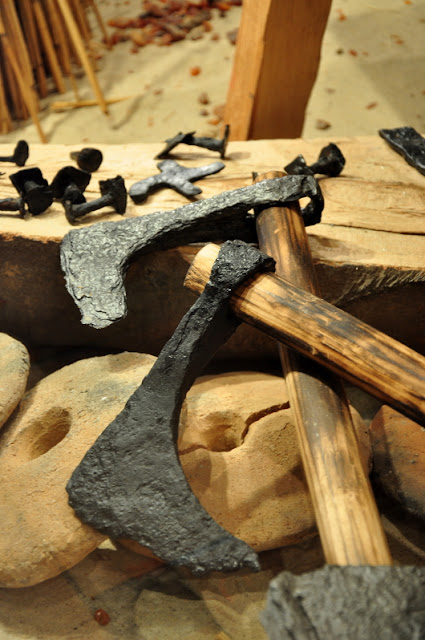Truso
Wulfstan sæde þæt he gefore of Hæðum; þæt he wære on Truso on syfan dagum and nihtum; þæt scip wæs ealne weg yrnende under segle. Weonoðland him wæs on steorbord, and on bæcbord him wæs Langaland, and Læland, and Falster, and Sconeg; and þas land eall hyrað to Denemearcan. And þonne Burgendaland wæs us on bæcbord, and þa habbað him sylf cyning. Þonne æfter Burgendalande wæron us þas land, þa synd hatene ærest Blecingaeg, and Meore, and Eowland, and Gotland on bæcbord; and þas land hyrað to Sweon. And Weonodland wæs us ealne weg on steorbord oð Wislemuðan.
Seo Wisle is swyðe mycel ea, and hio tolið Witland and Weonodland; and þæt Witland belimpeð to Estum; and seo Wisle lið ut of Weonodlande, and lið in Estmere; and se Estmere is huru fiftene mila brad.
Þonne cymeð Ilfing eastan in Estmere of ðæm mere ðe Truso standeð in staðe, and cumað ut samod in Estmere, Ilfing eastan of Estlande, and Wisle suðan of Winodlande, and þonne benimð Wisle Ilfing hire naman, and ligeð of þæm mere west and norð on sæ; for ðy hit man hæt Wislemuða.
Po Gdańsku ruszyliśmy do Truso, które to dziś prezentuje się niezbyt okazale. Pole jak każde inne. Skarby wszelakie zostały przewiezione do Muzeum Archeologiczno-Historycznego w Elblągu, gdzie elegancko i fotogenicznie są eskponowane. Duży plus dla muzeum (także za pozostałe wystawy).
A jak sięgnie się do polskiego tłumaczenia podróży Wulfstana to i staroangielski wydaje się zrozumiały.















Zaiste, piękne skarby.
OdpowiedzUsuńMoże wystarczy dzisiejszy angielski: "Wulfstan told he journeyed from Hedeby to Truso in seven nights and days, with his ship all the while under full sail. Wendland was to his starboard, and Langeland to his larboard together with Lolland, Falster, and Skåne. All this land is under the Danes’ command. Sometime thereafter Bornholm, which is an independent dominion with its own king, stood to the larboard. Pursuing Bornholm came the lands that have been called since the elderdays Blekinge, Möre, Öland, and Gotland. These are ruled by the Swedes [and Goths]. They remained to the larboard, and Wendland stood to the starboard ever until the mouth of Vistula. Nigh the large river of Vistula are situated Witland and Wendland. The previous belongs to the people of Esthland. Vistula runs out of Wendland and into a lake about fifteen miles wide, named Estmere (Vistula Lagoon). Then Elbing, east of Vistula, flows into Estmere, on the banks of which stands Trusö. Together the rivers reach Estmere, Elbing from the east out of Esthland, and Vistula from the south out of Wendland. Thereupon Vistula strips Elbing of its name, as it on the western end of the lake takes a northbound course and flows into the sea. Thereby the delta is called Vistula-mouth."
Z polską wersją też nie ma problemu, tłumaczenie mozna znaleźć u Labudy. Ale tak jest weselej :)
UsuńTak i ja odebrałem. Wasz blog jest wystarczająco treściwy pięknymi zdjęciami zabytków, co tylko zachęca do sięgania do literatury, nie tylko polskiej zresztą. Ukłony :)
UsuńA tak z ciekawości rekonstruktorskiej - ten bursztyn tak do ozdoby, czy ma dziurki nawierocne?
OdpowiedzUsuńNa zdjęciach są półprodukty i odpady poprodukcyjne. Ciekawa dyskusja wraz z materiałami źródłowymi znajduje się na forum Halla: http://halla.mjollnir.pl/viewtopic.php?t=1670 Pozdrawiam.
Usuń